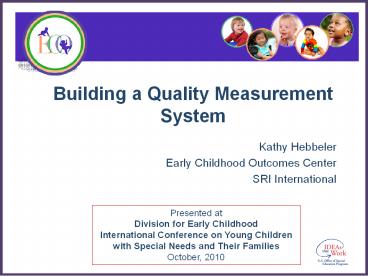Building a Quality Measurement System PowerPoint PPT Presentation
Title: Building a Quality Measurement System
1
Building a Quality Measurement System
- Kathy Hebbeler
- Early Childhood Outcomes Center
- SRI International
Presented at Division for Early
Childhood International Conference on Young
Children with Special Needs and Their
Families October, 2010
2
- "Success should be judged by results, and data is
a powerful tool to determine results. We can't
ignore facts. We can't ignore data." - President Barack Obama July 24, 2009
3
System for Producing Good Child and Family
Outcomes
- Profl Development
- Preservice
- Inservice
Evidence Based Practice
Good outcomes for children and families
High quality services and supports for children
0-5 and their families
Good Federal policies and programs
Good State policies and programs
Good Local policies and programs
Strong Leadership
Adequate funding
Information infrastructure
4
- A good information infrastructure is an essential
tool to providing high quality services and
supports.
5
Early Childhood Information Infrastructure
Data Needed for Program Improvement
WHO
SERVICES
OUTCOMES
COST
PERSONNEL
6
- A Framework and Self Assessment for Building a
Child Outcomes Measurement System
7
Purpose of the Framework
- Provide a common language for ECO and other TA
providers to use in discussing COMSs with states. - Provide a organizing structure of categorizing
resources and state examples related to
implementation of a COMS. - Serve as the organizing structure for the self
assessment
Early Childhood Outcomes Center
8
Framework and Self-Assessment
- Framework
- Set of components and quality indicators
- Provides the structure for the self-assessment
- Self-assessment
- Scale that provides criteria for levels of
implementation within each quality indicator - Rating assigned based on level of implementation
within each indicator
Early Childhood Outcomes Center
9
Process for Framework Development
- Built off what we had learned from ECO work with
states and previous ECO conceptual framework - Literature review
- Repeated discussion and review internally and
with 7 Partner States
10
Framework Partner States
State Part C 619
California X
Colorado X X
Delaware X X
Maine X X
Minnesota X X
New York X
Ohio X X
11
COMS Framework Components
Purpose
Analysis
Data Collection and Trans-mission
Reporting
Using Data
Cross-system Coordination
Evaluation
12
COMS Framework Components
Purpose
The state has effective procedures for
collecting, storing, and transmitting data to the
state.
Analysis
Data Collection and Trans-mission
Reporting
Using Data
Cross-system Coordination
Evaluation
13
COMS Framework Components
Purpose
State coordinates child outcomes measurement and
data use across EC systems.
Analysis
Data Collection and Trans-mission
Reporting
Using Data
Cross-system Coordination
Evaluation
14
Quality Indicator
- Provides additional detail as to what constitutes
quality implementation of the component. - 18 quality indicators across the 7 components
15
Quality Indicators for Data Collection and
Transmission
- 2. Data collection procedures are carried out
efficiently and effectively. - 3. Providers, supervisors, and others involved in
data collection have the required knowledge,
skills, and commitment. - 4. State's method for entering, transmitting, and
storing data is effective and efficient.
16
Structure of Self Assessment
- Components (7) Major areas of framework
- Quality Indicators (18 total) Statements of
basic requirements of a quality COMS - Elements (number varies with each indicator)
Define what constitutes high quality on the
Quality Indicator.
17
(No Transcript)
18
(No Transcript)
19
(No Transcript)
20
(No Transcript)
21
The Scale for the Quality Indicators
Implementation of Elements Quality Indicator Score
All elements are fully implemented 7
Nearly all elements are fully implemented and the rest are in process 6
Most of the elements are fully implemented and the rest are in process. 5
At least one element is fully implemented and the rest are in process 4
All of the elements are in process 3
Some of the elements are in process 2
None of the elements are yet in process 1
Early Childhood Outcomes Center
22
(No Transcript)
23
Recommended State Approach for Using the Self
Assessment
- Complete the entire self assessment.
- Identify the component(s) and quality indicators
to address first. - Develop action plan to improve the related
elements. - Implement improvement activities.
- Re-assess status and identify
next step priorities at regular
intervals
24
Next steps for ECO in developing the self
assessment
- Populate the COMS framework with resources
related to the components - Revise the self assessment based on feedback
- Develop a framework for a Family Outcomes
Measurement System
25
For more information
- For updates to the framework and the
self-assessment and resources to support the
quality indicators - www.the-eco-center.org

